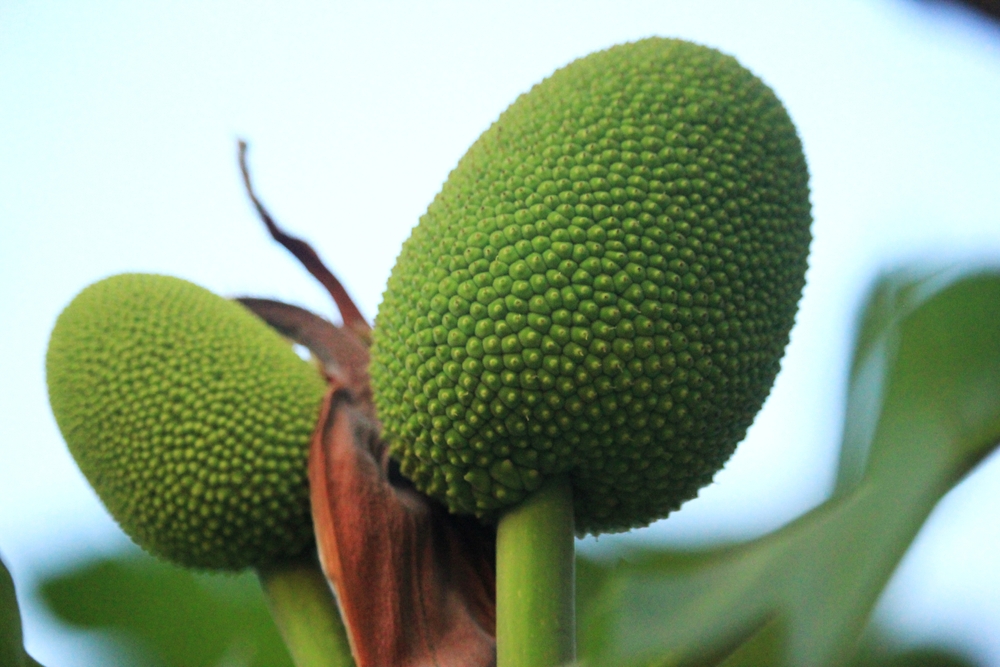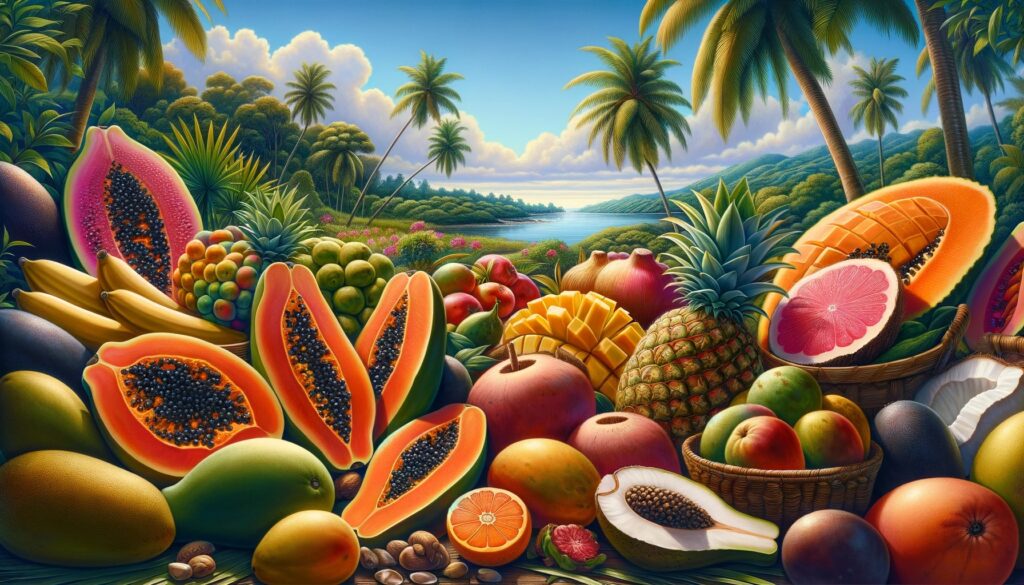Introduction to Oceania’s Tropical Fruits
A Glimpse into the Fruitful Bounty of the Pacific Islands
Oceania, a region rich in cultural and botanical diversity, offers a vibrant array of tropical fruits that are both delectable and healthful. The Pacific Islands’ warm climates and fertile soils create a perfect environment for growing an exotic fruit selection that offers unique flavors and culinary potential. From the sweet, succulent papayas to the tart and tangy pineapples, these fruits not only deliver a burst of tropical essence to the palate but also provide essential nutrients to the diet. Delving into the fruitful bounty of these islands allows one to experience the authentic splash of Oceania’s natural sweetness.
Spotlight on Key Tropical Fruits of Oceania
The Lusciousness of Papaya and Its Culinary Uses
Papaya, a true gem among tropical fruits, is renowned for its vibrant color and sweet, melon-like taste. It can be found gracing breakfast tables in sliced form, garnishing salads with its bright hues, and even starring in smoothies for a nutritious punch. But papaya’s versatility extends far beyond raw consumption. It’s also utilized cooked in stews, blended into sauces and marinades, and when unripe, Papaya lends itself splendidly as a vegetable in various local dishes. The presence of the enzyme papain makes it a tenderizer for meats, showcasing papaya’s multifaceted role in Oceanic cuisine.
Mangoes – The King of Island Fruits
Mangoes, often referred to as the king of fruits, thrive in the islands of Oceania and are cherished for their juicy sweetness and lush, fibrous flesh. Eaten fresh, they are a heavenly experience, but they also excel in various dishes, ranging from chutneys and salsas to sweet, sticky glazes that adorn grilled meats. Mango’s versatile nature finds its way into desserts, too, such as sorbets, ice creams, and tropical fruit salads. Its rich nutritional profile only adds to its royal status, providing a substantial source of vitamins A and C, among other beneficial compounds.
Coconuts – A Versatile Staple in Oceanian Diets
Coconuts are an indispensable part of Oceania’s culinary identity, offering a plethora of uses from their water, milk, oil, and flesh. Coconut water is a refreshing beverage, while milk is widely incorporated in cooking, imparting rich, creamy flavors to curries, desserts, and sauces. The oil is used for cooking and medicinal purposes, while the shredded flesh, or desiccated coconut, is a common ingredient in sweet confections and garnishes. Its status as a diet staple underscores the coconut’s integral role in the traditional and modern kitchen of Oceania.
Pineapple – The Sweet Taste of the Tropics
Pineapple, synonymous with tropical delight, stands out for its zesty sweetness and tangy twist that enlivens the taste buds. It is as delicious and consumed fresh as it is grilled or baked, with its natural sugars caramelizing to perfection. A staple in Hawaiian pizzas and a key component of refreshing fruit salads, pineapple’s citric flair also makes it an ideal partner for savory dishes. In Oceania, pineapple commonly finds its way into chutneys, drinks like pina coladas, and meats where its acidic properties tenderize while adding a unique flavor profile.
Breadfruit – From Savory to Sweet Preparations
Breadfruit is a true chameleon in Oceanic cookery, adaptable in both savory and sweet applications. This starchy fruit, once a staple food for Polynesian voyagers, is commonly roasted, baked, or fried. Its potato-like texture makes it an excellent dish base, often substituting for rice or flour. In sweet preparations, breadfruit can be transformed into delectable pies or puddings, absorbing the rich flavors of coconut and vanilla. Its growing popularity is also seeing it turned into chips and gluten-free flour, showcasing its wide-ranging culinary potential.

Traditional Desserts and Sweet Treats Using Tropical Fruits
Hawaiian Haupia – A Coconut Milk-Based Dessert
Haupia is a traditional Hawaiian dessert that exemplifies simplicity and tropical flavor. Made primarily from coconut milk and thickened with arrowroot or cornstarch, this pudding-like treat is a testament to the coconut’s versatility. Typically served at luaus and other festive occasions, haupia’s creamy consistency and coconut’s subtle sweetness make it an instant favorite. Often set into squares and garnished with toasted coconut flakes, haupia can also be layered with other flavors like chocolate, creating a fusion that’s both innovative and steeped in tradition.
Fijian Vakalolo – A Sweet Cassava and Coconut Delicacy
Vakalolo is a beloved Fijian dessert featuring the satisfyingly sweet combination of cassava and coconut. This dessert, made by steaming a mixture of grated cassava, coconut milk, and sugar, offers a glimpse into Fiji’s resourceful use of local ingredients. The result is a sticky, dense, and delectably sweet concoction, embodying the comfort of traditional Fijian sweets. Vakalolo is often flavored with pandanus leaves, adding a layer of aromatic depth that makes it a comfort dish with a distinctively tropical essence.
Samoan Fa’ausi – Taro and Coconut Cream Treat
Samoa’s fa’ausi is a heartwarming treat that marries the earthiness of taro with the luxurious taste of coconut cream. This dish involves boiling and mashing taro until smooth, then forming it into balls which are drenched in a sweet coconut cream sauce. The natural nuttiness of taro pairs wonderfully with the rich, sweet cream, creating a harmony of flavors that’s both indulgent and deeply satisfying. As a staple celebration food, fa’ausi holds a special place in Samoan culture, relished during feasts and special occasions.
Modern Dessert Innovations with Tropical Fruits
Contemporary Twists on Classic Fruit-Based Desserts
As the culinary world evolves, classic desserts are being reinvented with a tropical twist through the ingenious use of Oceania’s fruits. Traditional cakes are now being infused with flavors like mango, papaya, and pineapple, adding depth and brightness to each bite. Chefs also craft creative versions of tarts and crumbles, incorporating breadfruit and coconut to reimagine these cozy classics. The agility of these tropical fruits to blend with contemporary dessert trends is a testament to their timeless appeal and endless adaptability in modern cuisine.
Fusion Recipes Blending Tropical Fruits with Global Flavors
The vibrant taste of Oceania’s fruits has inspired a wave of fusion recipes that marry local flavors with global influences. Chefs experiment by adding tropical elements to dishes like French pastries, Italian gelatos, and even Middle Eastern desserts, creating a cross-cultural culinary conversation. These innovative recipes showcase the flavors of the Pacific Islands and introduce them to new audiences, allowing tropical fruits to shine in unexpected and deliciously unique ways.

Health Benefits of Tropical Fruits in Oceania’s Diet
Nutritional Profiles and Wellness Advantages
The consumption of tropical fruits in Oceania is not only a sensory pleasure but also a healthful choice. Fruits like papayas, mangoes, and pineapples are brimming with vitamins, minerals, and antioxidants, contributing to overall wellness and disease prevention. The dietary fibers found in these fruits aid digestion, while the rich vitamin C content supports the immune system. Additionally, their hydrating qualities and low calorie content make them ideal for maintaining a healthy lifestyle. Inclusion of these nutritious powerhouses in the Oceanic diet exemplifies the perfect blend of flavor and well-being.
Preparing and Enjoying Tropical Fruits in Everyday Meals
Tips for Selecting, Storing, and Preparing Fresh Fruits
Enjoying the full flavor of Oceania’s tropical fruits starts with proper selection and storage. When choosing fruits like mangoes and papayas, look for those that give a little under pressure, indicating ripeness. For storage, most tropical fruits should be kept at room temperature until they reach peak ripeness and then moved to the refrigerator to prolong freshness. In preparation, understanding the unique properties of each fruit is key—whether it means waiting for breadfruit to soften before baking or using a sharp knife to remove pineapple skin cleanly. With these considerations, the true essence of these exotic fruits can be captured in home cooking.
Simple and Refreshing Fruit-Based Meal Ideas
Integrating tropical fruits into daily meals can add both nutritional value and a burst of zesty flavor. A simple fruit salad with a drizzle of lime juice makes for a refreshing side dish, while a mango salsa can brighten up grilled fish or chicken. Fruits like papaya and pineapple can be the star ingredients in smoothie bowls, topped with nuts and seeds for an energizing breakfast. Even savory dishes benefit from the sweetness of fruit, such as pineapple fried rice or a coconut-infused curry. These simple ideas make it easy to enjoy the diverse character of tropical fruits in every meal.
Celebrating Tropical Fruits in Oceania’s Festivals and Gatherings
Fruit’s Role in Cultural and Social Events
In Oceania, tropical fruits are celebrated as much for their cultural significance as their flavors. Fruit is central in many Pacific Island festivals and social gatherings, symbolizing hospitality and abundance. Fruits are lavishly presented during feasts like the luau in Hawaii, where pineapple and coconut feature prominently in dishes. They play a role in traditional ceremonies, often being used as offerings or decorations. The shared experience of enjoying these fruits fosters a sense of community and connection to the islands’ rich heritage.
FAQs on Using Tropical Fruits in Oceania’s Cuisine
How Do You Properly Ripen and Store Tropical Fruits?
To properly ripen tropical fruits, keep them at room temperature, away from direct sunlight. Fruits like mangoes, papayas, and bananas emit ethylene, which speeds up ripening. Hence, they can be placed in a paper bag to ripen more quickly. Once ripened, store them in the refrigerator to extend their shelf life. However, fruits such as pineapples and coconuts do not continue to ripen once harvested, so they can be stored as is. Always check for any signs of over-ripening or spoilage, and consume them while they’re fresh and at peak flavor.
What are the Best Methods for Cutting and Preparing Tropical Fruits?
Each tropical fruit has its best method for cutting and preparation. For instance, with mangoes, you can slice along the sides of the pit, score the flesh without breaking the skin, and then invert the piece to cut or scoop out cubes. Pineapples require removing the top and bottom, standing it upright, and cutting the skin off from top to bottom. Breadfruit can be peeled and cored before cooking. Always use a sharp knife and take care to avoid waste, while getting the most out of each fruit’s edible parts.
Can You Substitute Tropical Fruits in Traditional Recipes?
Yes, you can substitute tropical fruits in traditional recipes to add a twist or enhance nutritional content. In recipes such as pies, crumbles, and salads, many fruits like mangoes, papayas, and pineapples can replace apples, pears, or peaches. Using tropical fruits can inject vibrant flavors and make a dish more exciting. However, consider the fruit’s texture and moisture content when substituting to ensure the recipe’s integrity. For instance, some fruits may release more juice when cooked, impacting the dish’s final consistency.
What are Some Classic Oceanian Desserts Featuring Tropical Fruits?
Classic Oceanian desserts featuring tropical fruits include the Hawaiian Haupia, Samoan Fa’ausi, and Fijian Vakalolo. Haupia is a coconut milk-based gelatinous dessert, Fa’ausi combines taro balls with coconut cream, and Vakalolo is a sweet steamed cake made from cassava and coconut. These desserts are deeply rooted in the tradition and hospitality of the respective cultures and offer an authentic taste of the tropics. They highlight the flavors and versatility of local fruits and are cherished components of Oceanian cuisine.
Are There Any Unique Cooking Techniques Involving Tropical Fruits in Oceania?
In Oceania, unique cooking techniques that involve tropical fruits are a part of the culinary tradition. For example, cooking in underground ovens known as ‘umu’ or ‘lovo’ is a method used to infuse smoky flavors into dishes. Breadfruit and bananas may be wrapped in banana leaves and slow-cooked in these pits. Another technique is using fruit as a natural tenderizer, where the enzymes in papaya and pineapple break down proteins in meats. These traditional methods have been passed down through generations and offer a distinct and flavorful cooking style.
